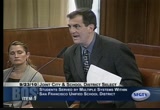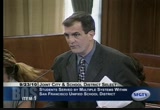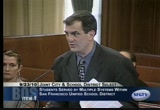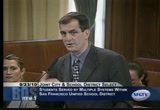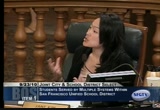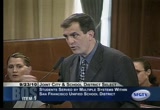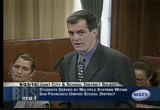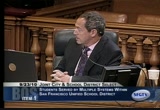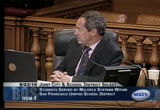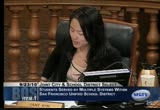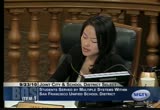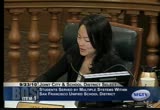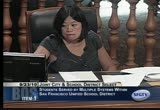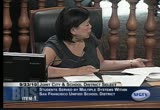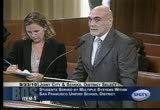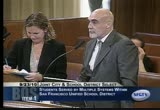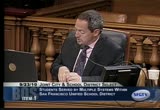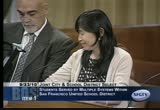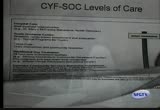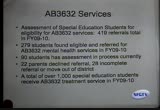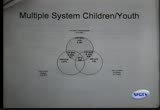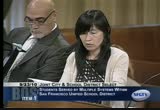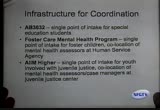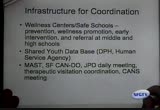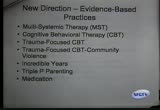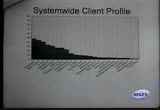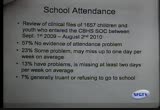tv [untitled] September 27, 2010 11:30pm-12:00am PST
12:30 am
and going to field trips and job shadowing. just this week we're into moving the students into some of the internships that are around our sight all over the city and all over the city -- some of the students are interested in automotive technicians. some are interested in being in doctor offices. it's really robust. it's really happening much more quickly than is expected. with the help -- there's an internship coordinator that's partnered by the school model. so that's the big picture. >> could you -- i wasn't familiar with your school. so for those that are watching, would you give a little background on your school. i guess enrollment fluctuates. >> sure, absolutely. it's an existing school.
12:31 am
at the begin og this year, there were 60 students, probably 50 to 60 students and that grows as the year goes on. big picture schools, there are 50 around the world, the idea is to building -- build around the student. for example, they start doing research into the spca which would culminate in two days a week, tuesdays and thursdays going to an internship who has a mentor further their education. they bring that back to their school. they study all the different subjects within the spca or organizations like that. it's a multilevel organization where you are going to be adding some of your core
12:32 am
classes. could be going to college. could be through a workshop at the sight. and it culminates every nine weeks in what they call an exhibition. it's very, very important for students the writing and making a 45-minute presentation every nine weeks. soy think it's going to be great for our students. we've seen the result of that. if you saw the students at matt west that's where we'd like our students to be. so we're really excited about that. >> thank you. >> commissioner kim? >> oh. thank you. since we visited matt west, kind of where we're at in terms of the first six weeks. i'm really excited partnering with big picture. they're doing a great academic
12:33 am
studies. i think i talked to someone about this. is it changing a bit? are they staying at principal center for the rest of their time through school? how's that working now? >> that's a great question. for students, this is a complete change from the principle center. they were sentenced and that's the way they view going to principle center. we really wanted to change that >> right now it is probation only. we're starting small. we're going to do where students are placed at principle center. we have an interview process. they have a choice that they are placed there. we have an interview process where we show them the big picture videos and this is what the school is going the be about. is this something you'd like to be a part of. when it is over, you are absolutely able to stay here at big picture if you'd like. and the motto as ms. kim goes,
12:34 am
it -- model, as ms. kim goes, it could go on for years. students who are older and are close to graduating and may want to graduate from their regular comprehensive school. that's how we would tailor that they're program. >> is there a point where we're not going to be able let students -- i think continuity is so important for our students in general, especially when they come to principle center. >> we have six advisories and the optimum -- the maximum number in each advisory is 15 given the sight logistics, they're small bing lows. we're hoping that they 140 students. wore hoping to move into another place next year and increase our population up to that number. but i think at principle center, i think we're going to be -- i would have to say 70 to
12:35 am
80 students batesed on that sight. >> the students are exploring their interest and the interest coordinator is looking to find their interest and is going through the interview process. >> the students are actually -- the growing part of big picture is that the students actually doll the internship explore ration themselves and that's a big change. the internship coordinator and all of us help them do that, but it's really their job to do the cold cobs, to find out what they do at their jobs, the job shadowing and finally mind a mentor and move into that. we expect that to happen at around the ninth week based on what's happening so far. >> there's something i loved last year that the students took the initiative, and the staff helped them write scripts.
12:36 am
we're doing this work with the buchanan ymca and j.v.c. in terms of this school program. are we able to do some professional development so there's a level of consistency. i think it would be great if there's a level of consistencey? >> i think that's a great idea. i think we could certainly do that. we're certainly available to do some professional development from our sight as the matt west site has done for us. absolutely. >> any of you familiar with the europe program? >> i just want to say that having had a lot of exposure to working with young people in that program, i think that they do an outstanding job of getting young adults prepared to give you that strong handshake, look you in the eye, directly ask you a question -- your presentation talks about 21 century skills.
12:37 am
i'm interested in asking -- what do those look like? is there something that looks different that we want our students to have. but beyond that i would like to suggest that maybe europe could offer some support not having to reinvent the wheel but to bring people in that really do that and i think do an excellent job to that. i think they'd be very open. i'm hoping the superintendent is smiling and that's usually a bad sign. >> on that note because this is a new initiative and again some of these programs are employees. some are starting from concept, ground zero and moving forward. we are bringing the four sites together. we'll be visiting other models to be a part of that program in terms of bringing everyone up to speed on what are some best
12:38 am
practices. it might not be an internship coordinator but there will be that type of role. trying to allow for the needs of each school but providing those practices and training -- best practices to all the sites as we kind of move forward. >> along those lines i'd also point to co ral foundation where they work with high school students and they work with individuals that are post college. but there's a very strong emphasis on creating a culture and you feel like you're part of a very unique experience and how you think and what you -- how you rationalize issues and how you solve them. that would be great just to draw from some of those elements. a number of your students i have had the privilege of having a student that will be graduating this year from downtown high school. one of the things that i've learned is when you talk about many of these students, they've
12:39 am
had such bad experiences with school themselves and so i'm just wondering how do you go about the buy-in process. -- process? are you doing focus groups? do you get young people that are turned off by the process and turn the page and recognize that this will be a different experience for them, hopefully. >> the approach has been -- how we conceptualize the model, the schools will determine what student will benefit from this experience. they have slightly different target population but leaning toward the school staff to identify who really is interested, willing or they think could really benefit from it. >> where i have a problem with that is that i've had the student with me and she stayed in trouble with the leadership of our school because she was consistently 20 minutes late
12:40 am
because she was responsible for getting her younger sibling to element school. there's no way she couldn't do that. but she stayed in trouble about things that i'm not sure were the most important things to be in trouble about. i come back to the point that i just don't want to cherry pick in this environment because i think that they're enormously talented kids. they would not be the kids that you would most identify at any of these schools. i hope you'll be mindful of that and that's why i talk about something -- a buy-in process that's really a little different than the school leadership than a teacher or a principal identifying that these are the right kids for this experience. so i would just be my beg. >> this is just a pilot process. it varies with each school. principle center is the exception.
12:41 am
it's not schoolwide at this point. but we're hoping that this three-year cycle funding will inform how to make all high school experiences, relevant and focusing on 21st century and learning in that marketplace. so this is just the beginning. but we'll definitely keep those considerations in mind. >> commissioner? >> oh, i actually had a couple of questions, but i guess it's still formulating in regards to placing students in retail and transportation logistics. what does that mean? like does that mean starbucks? i'm trying to get a sense -- >> i think you were refering to the sectors. those are the sectors that the office has identified as kind of the growing sectors. overseing kind of the city's workforce dollars for you has been trying the align those based on those efforts.
12:42 am
they will have job opportunities in the future. we included that as options but the programs are not limited to those fields. but those have been identified as the biggest growth areas. it's not a requirement. >> what is transportation logistics? >> would have to ask my colleagues. >> i think it's great to have these industries but just to have a better sense so they're not just filing. i know how internship works. i mean, if we could partner with organizations that do kind of more incubating helping people start businesses, you know, working with those kinds of organization so that we're really tapping into young people's creativity as much as possible. i think that that would be important. what were the other two schools that you identified because i
12:43 am
only saw four or five? i assume independence high school is considered a cool. what's the sixth school? there were six schools originally identified. we're working on other partnerships at sixth center but not with the specific model. just to emphasize what supervisor dusty said, but we know that there are a certain number of students that are under-credit already. whenever we get the expulsions and we see theas students that are under credit. we say what are we going to do for them. we already know in advance that a certain number of students are going to be meeting this criteria as much as possible if we can't have consistent criteria. so kind of like the supervisor
12:44 am
said we're not cheery picking them. i'm glad that we're doing this. it sounds like it has a lot of potential. >> commissioner furor? commissioner furor: thank you. i have a question and my question is what about undocumented students? are they able to participate this and have a paid internship or -- >> absolutely. within the school, we don't identify undocumented youth. there's no way that we do that. they would fully participate in all the internships, yes. >> some of it is credit based and it's worked for this experience. isn't there some wages involved. yeah >> so they don't need a social security number, i'm assuming?
12:45 am
>> i'm not exactly sure. >> so maybe we can look into that. >> the think -- thing about city college is that we've run into a problem with our undocumented students that they're requiring them to pay because of indocumentation. >> we are in discussion right now. >> if the students can get credit as long as they're still enrolled in our school system. >> ok. great. >> i have one more question. who's developing tools to be using or measuring. is that with you kevin? >> it's a partnership. all of the dcyf date us. they do go through ri tu cana. so we work in partnership on
12:46 am
many of the projects with d crrks yf. >> ok. so -- dcyf. >> ok. so to measure the program's effectiveness, both of you are developing the measures. certainly school attendance and school engagement is going to be at the top of the list. we're incorporate rating the school require jments -- requirements. our post secondary program is college prepared, college ready, there are goals that defined their readiness. and i i that those certainly -- the goals that we have within our high schools. building goals to identify as students get to their senior
12:47 am
year how ready they are. they have a post secondary success plan. attending school, engagement, like i said building a portfolio of their experience with their success with the big picture. they have -- they actually do oral presentations. what's it called? exhibition. thank you they actually locate their learning. so it's atanments of those goals and how successful we are meeting their goal in internship. >> every nine weeks there's an exhibition, is that correct? >> that's right. would you be so kind as to for toward board the schedule so members would be able to visit and observe? ok. thank you very much.
12:48 am
>> we have representatives from human services agency. what i'd like to do first is again, underscore that the following city departments are following up and updating us. we had a hearing about the importance of coordination for students in multiple systems. students being served by multiple systems. i'd like to invite the -- si ling. i'm heavily indebted to si ling
12:49 am
for coming today. >> hold on one second. our clerk ms. casco is going to make sure ormicrois on. >> good afternoon. thank you very much supervisors and commissioners for inviting me to come back and present on this multisystem children and youth and the progress that we've made in terms of making programs for accessible and effectiveness. i want to walk through my presentation. we'll do a very quick overview of what we kernly offer in terms of level of of care. and then some of our current structure for communication working together among the multi-- the department city
12:50 am
departments and nonprofit agencies. also the decision-making system in our services. to the next page, actually talks about the multiple level of career, which is a slide. it goes from the most strict level of care. patient hospitalization and we use st. mary's hospital as our primary hospital for it. sometimes if we're really full, we have services in juvenile center.
12:51 am
we have a small number of children that we place in residential street. . and then this intensive services. and also nonresidential day treatment. and then we also contract with 60 c.b.o.'s to provide outpatient services of various kinds. and we have prevention services. but yeah, so then the next is just a quick overview as to the number of kinds that we serve with open -- open shots. about 5,000 times that we served every year in increasingly smaller snurms --
12:52 am
numbers. they serve 28 pre-k and this is the child development center. 41 elementary schools. 11 middle schools, and 21 high schools. this is for your rerns. on to -- reference. this is a state mandated services. it's an assessment unit that we created the essential services we said three to two units. 259 students were found eligible. 90 students at duke having their assessment right now. the family actually moves out the district.
12:53 am
this is just the new intake for last year. over 1,000 students are receiving outpatient care. next talks about children and youth. this is from the dada 2007, 2008. at that time we look out of the 5,000, 102 of them are in that system, in mental health in and also in juvenile probation. it's a very high need. >> this appears to be i think it was the last time was 150. >> it came down a little bit. but it's probably -- it probably has to be placed. the number has gone down.
12:54 am
>> ok. but it also could be for the great year it has gone down too. so just some quick characteristic of who these 102 children are. the majority of them, afternoon, 70%. followed by latin 14rks slrs. and asian america 5.9 person. mostly mail and 40% female. actually they -- this is the ethnicity and this is gender. so the next one, you can see it starts from --. the peak of the age is 14 years old and then followed by 16.
12:55 am
the next time is on neighbor. the stop several neighbors where they are used to living in the edition. what's an edition. >> this is a quick overview i talk about it that it's a single point of intake for children. we call location of our workers. and we have stayed aim high program. we have colo cation of co-location in juvenile hall. as students we work very
12:56 am
closely with the wellness centers in the safe schools. one is more promotion. we have to share where the human gets involve. there's a math meeting with the cantu project and then we had sarah put up the meeting. >> one of the things that we have learn sd that things fall through the cracks. so we try to really communicate and so the next one, based on the american citation
12:57 am
association recommendation. eso this is a well researched and well evidence. there's a law that has a good outcome for you being involved in the criminal system. c.b.t. is a well known treatment for. there's also focus community violence. education is also another evidence they practice. next set, the slide talks about changing the way we do our business. for the past three years we do a system on decision making. and we adopted it.
12:58 am
we had two that we also shared with probation and with child welfare. it's a really useful to check out come. -- useful information to check outcom. i'm going to skip some of the profile. this is just a snapshot of -- with a list in spring of this year to year. the fifth one is hyper activity. and how do these problems impact the client's functioning? i know the next line talks about school achievement. the family, school behalf or.
12:59 am
-- behavior. and then living situation. we know we have a lot of work to do. >> we also take a look at 1,557 children in our youth. we try to understand how truancy is being affected in our system. of all the open cases 57% had no tennis problem. but 22% would miss three day as week. so that's about 100 children and youth. the last line and this is my last presentation, it talks about the change. so if we find these needs and we find the pres
53 Views
IN COLLECTIONS
SFGTV: San Francisco Government Television Television Archive
Television Archive  Television Archive News Search Service
Television Archive News Search Service 
Uploaded by TV Archive on

 Live Music Archive
Live Music Archive Librivox Free Audio
Librivox Free Audio Metropolitan Museum
Metropolitan Museum Cleveland Museum of Art
Cleveland Museum of Art Internet Arcade
Internet Arcade Console Living Room
Console Living Room Books to Borrow
Books to Borrow Open Library
Open Library TV News
TV News Understanding 9/11
Understanding 9/11